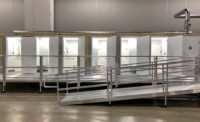Robust growth continues in Arizona, Nevada and New Mexico, according to the results of ENR Southwest's annual survey of general contractors. The survey's top 10 firms reported combined revenue of more than $3.1 billion in 2014, up from $2.6 billion in 2013. Additionally, eight of the top 10 saw revenue increase last year, although three firms among last year's top 10 dropped to lower positions on the list.
Improving conditions have led some regional construction leaders to believe the Southwest is poised to return to growth levels not seen in nearly a decade.
"According to our own market forecasts, the Southwest is back in growth mode," says Jeff Perelman, senior vice president and chief growth and strategy officer with contractor Sundt, Phoenix. "Population is the foundation of sustainable growth, and over the next five years Arizona and Nevada will lead the U.S. in percentage gains."
Growth will come, agrees Bo Calbert, president, McCarthy Southwest, Phoenix, although exactly when population gains and other conditions impact construction remains to be seen.
Meantime, particular sectors continue to sustain regional builders.
"While the Southwest will require time to fully recover from economic downturn, activity is robust among industries involving natural resources," Calbert says.
Among the more critical resources is water. With supply issues dominating discourse throughout the Southwest and California, Calbert says contractors will be recruited to contribute engineering solutions to the problem.
"Advanced water treatment plants and the concept of 'toilet to tap' are gaining traction again," he says.
Meantime, sectors ranging from health care to site-specific, multifamily residential construction will continue to drive regional development, says Ross Vroman, executive vice president and general manager with Skanska, Phoenix.
"On the horizon, we see transit-oriented, multifamily and industrial development," Vroman says. In the health care arena, "organizations are working to position themselves as scalable and adaptable," he adds. "We expect the market to remain stable and increase slightly."
Volman also foresees a bump in smaller scale backfill/infill projects as well as an increase among build-to-suit projects among large end-users.
Calbert notes sustainable energy will likely remain strong in the region, but in new locations. "We're seeing more communities embrace the idea of reusing land surrounding landfills and airport runways for solar fields and energy production," Calbert says.
Need for Collaboration
As new projects and project types continue to spur regional activity, successful execution will continue to rely on collaboration among all shareholders.
"We're able to deliver product in competitive markets with less risk when the entire team collaborates from the onset," says Vroman. "It's an approach that allows us and our colleagues to preplan and address challenges early."






